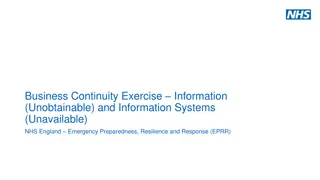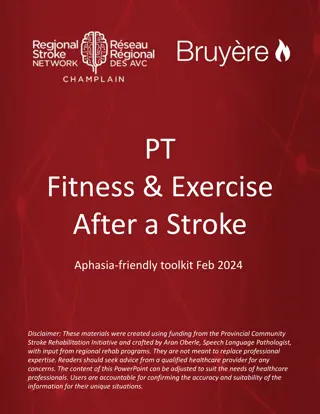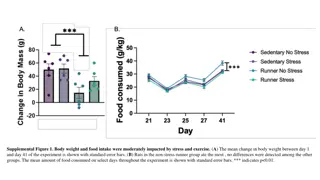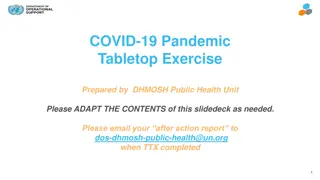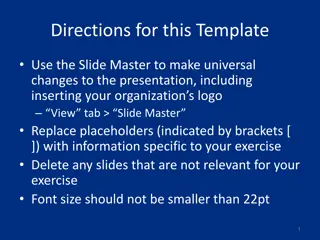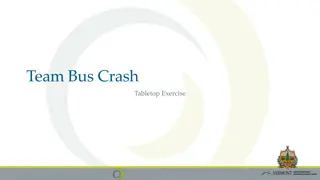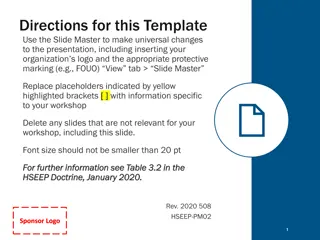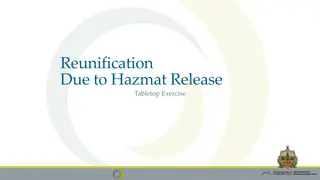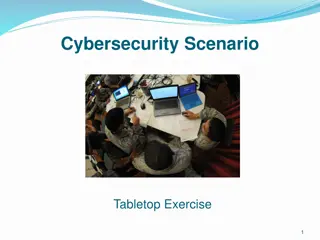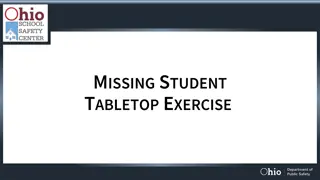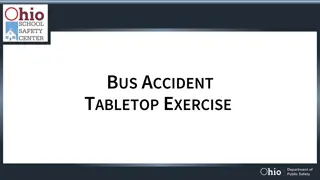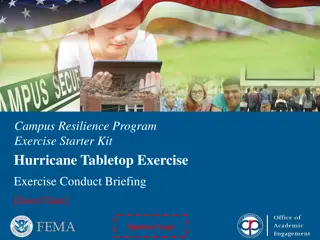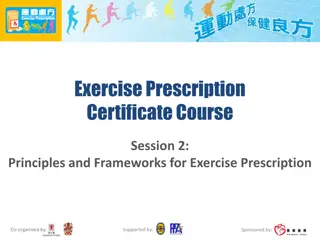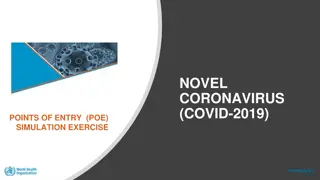HSEEP - Capabilities-Based Exercise Program Management
A consistent approach using a common methodology to measure progress in building, sustaining, and delivering core capabilities. HSEEP provides guidance on program management, design, development, conduct, evaluation, and improvement planning, emphasizing the importance of translating priorities into specific objectives and exercises. The cycle involves identifying priorities from various sources, coordinating exercise activities, and making improvements based on after-action reports. HSEEP is not a legal requirement, allowing flexibility in planning and documentation to adapt to diverse needs.
Download Presentation

Please find below an Image/Link to download the presentation.
The content on the website is provided AS IS for your information and personal use only. It may not be sold, licensed, or shared on other websites without obtaining consent from the author.If you encounter any issues during the download, it is possible that the publisher has removed the file from their server.
You are allowed to download the files provided on this website for personal or commercial use, subject to the condition that they are used lawfully. All files are the property of their respective owners.
The content on the website is provided AS IS for your information and personal use only. It may not be sold, licensed, or shared on other websites without obtaining consent from the author.
E N D
Presentation Transcript
HSEEP How Simple Exercises Explode Perpetually??? Karla Black, Kent County Health Department
What is HSEEP? A consistent approach to capabilities-based exercise program management that uses a common methodology to measure progress toward building, sustaining, and delivering core capabilities. 2
HSEEP Guidance HSEEP Fundamentals Program Management Design and Development Conduct Evaluation Improvement Planning http://www.fema.gov/media-library-data/20130726-1914-25045-8890/hseep_apr13_.pdf 3
Where priorities come from National threats and hazards Jurisdictional threats and hazards Hazard vulnerability analysis Threats and Hazards Real-world incident corrective actions Exercise corrective actions Identified and/or perceived areas for improvement Areas for Improvement/ Capabilities Industry reports State or national preparedness reports Homeland security strategies External Sources Requirements Accreditation standards and/or requirements Grants or funding-specific requirements Occupational Safety and Health Administration regulations Accreditation Standards/Regulations 5
Training and Exercise Planning Workshop (TEPW) Translate priorities into specific objectives and exercises Track IP actions against current capabilities, training, and exercises Coordinate exercise activities Identify and coordinate possible funding sources MCM ORR Capability 3, Function 5 b & c 6
HSEEP is guidance, not law! At least according to FEMA Not all exercises require the same amount of work/planning. Planning meetings Documentation Capabilities differ across disciplines After Action Reports/Improvement Plans Make it fit for you! 8
Preparedness Toolkit https://preptoolkit.fema.gov/web/hseep-resources 9
Courses that are available FEMA Independent Study Courses (Online) IS-120.a An Introduction to Exercises IS-130 Exercise Evaluation and Improvement Planning FEMA L146 HSEEP Online delivery or in person FEMA s Master Exercise Practitioner Program 3 courses over 3 weeks at the Emergency Management Institute (EMI) Application period starts May 1 MCM ORR Capability 3, Function 5, Planning b: Advanced 10
AAR The After Agony Report Larry Zimmerman, MDHHS
After Action Report (AAR) Demystifying the AAR 12
Why AAR? A few reasons: To prove to the DEPR/CDC completion of training and exercise deliverables/requirements To verify strengths or identify weaknesses in plans, training and equipment To build a roadmap to correct identified gaps Funding opportunities/Leadership buy-in 13
Why AAR? A few more reasons: To learn from and share our experiences? To document new ideas and unique processes? To build community relationships? Score ultimate level on the ORR 14
The HSEEP AAR Template Download from the Preparedness Toolkit https://preptoolkit.fema.gov/web/hseep- resources 15
Basic sections of the HSEEP AAR Cover Page Exercise Overview Analysis of Capabilities Improvement Plan 16
Cover Page 17
Exercise Overview [Insert the formal name of exercise, which should match the name in the document header] Exercise Name [Indicate the start and end dates of the exercise] Exercise Dates This exercise is a [exercise type], planned for [exercise duration] at [exercise location]. Exercise play is limited to [exercise parameters]. Scope [Prevention, Protection, Mitigation, Response, and/or Recovery] Mission Area(s) [List the core capabilities being exercised] Capabilities [List exercise objectives] Objectives [List the threat or hazard (e.g. natural/hurricane, technological/radiological release)] Threat or Hazard [Insert a brief overview of the exercise scenario, including scenario impacts (2-3 sentences)] Scenario [Insert the name of the sponsor organization, as well as any grant programs being utilized, if applicable] Sponsor [Insert a brief summary of the total number of participants and participation level (i.e., Federal, State, local, Tribal, non-governmental organizations (NGOs), and/or international agencies). Consider including the full list of participating agencies in Appendix B. Delete Appendix B if not required.] Participating Organizations [Insert the name, title, agency, address, phone number, and email address of the primary exercise POC (e.g., exercise director or exercise sponsor)] Point of Contact 18
Analysis of Capabilities Aligning exercise objectives and core capabilities provides a consistent taxonomy for evaluation that transcends individual exercises to support preparedness reporting and trend analysis. Table 1 includes the exercise objectives, aligned core capabilities, and performance ratings for each core capability as observed during the exercise and determined by the evaluation team. Performed with Major Challenges (M) Performed with Some Challenges (S) Performed without Challenges (P) Unable to be Performed (U) Objective Core Capability [Objective 1] [Core capability] [Objective 2] [Core capability] [Objective 3] [Core capability] [Objective 4] [Core capability] 19
Analysis of Capabilities [Objective 1] The strengths and areas for improvement for each core capability aligned to this objective are described in this section. [Capability 1] Strengths The [full or partial] capability level can be attributed to the following strengths: Strength 1: [Observation statement] Strength 2: [Observation statement] Strength 3: [Observation statement] Areas for Improvement The following areas require improvement to achieve the full capability level: Area for Improvement 1: [Observation statement. This should clearly state the problem or gap; it should not include a recommendation or corrective action, as those will be documented in the Improvement Plan.] Reference: [List any relevant plans, policies, procedures, regulations, or laws.] Analysis: [Provide a root cause analysis or summary of why the full capability level was not achieved.] Area for Improvement 2: [Observation statement] Reference: [List any relevant plans, policies, procedures, regulations, or laws.] Analysis: [Provide a root cause analysis or summary of why the full capability level was not achieved.] 20
Custom AAR writing Linking Capabilities, Objectives, and Functions Referencing plans/processes Capability 1: Community Preparedness Function ID Operational Implementation Element Exercise Objectives/Activities Function 2: Build community partnerships to support health preparedness The jurisdiction can provide evidence of how the roles and responsibilities of how private sector, local, state, and regional partners have been used. Capability Analysis: VBCDHD will designate roles and responsibilities to volunteers within Jurisdiction based on exercise scenario. 1 Analysis: VBCDHD successfully identified roles needed to respond the scenario. Specific qualifications for individuals were identified based on how volunteers resisted themselves within MI Volunteer Registry. By registering as a volunteer within MI Volunteer Registry, members of the private sector, local, state, and regional partners are agreeing to accept roles and responsibilities during a public health emergency based on their availability. During the exercise VBCDHD tested the functionality of establishing a mission, and creating deployment/assignments lists based on roles and responsibilities of the scenario. The creation of missions, deployment groups and assignments lists were completed to the best of the ability of the registered volunteers. Improvement Plan: NA 21
Improvement Plan Issue/Area for Improvement Primary Responsible Organization Capability Element Organization POC Completion Date Core Capability Corrective Action Start Date Capability 1: [Capability Name] Capability 1: [Capability Name] Capability 1: [Capability Name] Capability 1: [Capability Name] Capability 2: [Capability Name] Capability 2: [Capability Name] Capability 2: [Capability Name] Capability 2: [Capability Name] 1. [Area for Improvement] [Corrective Action 1] 1. [Area for Improvement] [Corrective Action 2] 2. [Area for Improvement] [Corrective Action 1] 2. [Area for Improvement] [Corrective Action 2] 1. [Area for Improvement] [Corrective Action 1] 1. [Area for Improvement] [Corrective Action 2] 2. [Area for Improvement] [Corrective Action 1] 2. [Area for Improvement] [Corrective Action 2] 22
Tips for AAR writing AAR writing starts at the beginning of the exercise design process Measurable Objectives Strong Evaluations Collaboration and Teamwork 23
Why AAR? To continually measure and increase our ability to protect the public: 24


